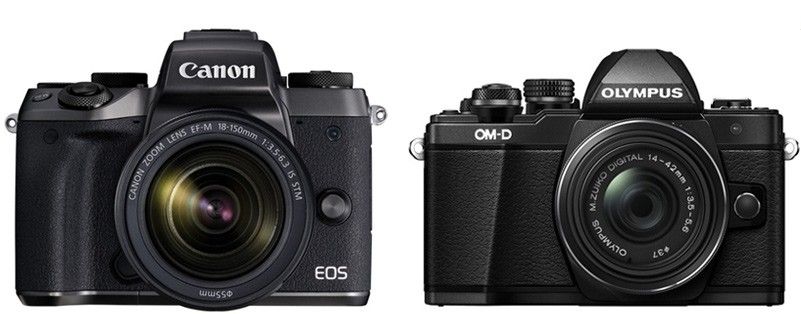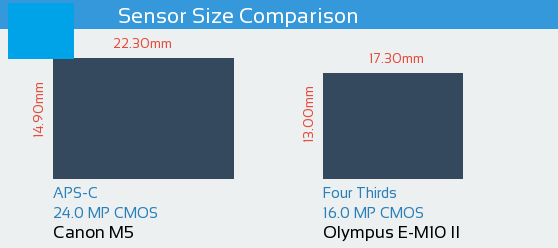Canon M5 vs Olympus E-M10 II
: These are two mirrorless cameras. This article compares Canon’s Semi-Pro Mirrorless camera, the Canon EOS M5, with Olympus’ Semi-Pro Mirrorless camera, the Olympus E-M10 II. The EOS M5 features a 24.0MP APS-C sensor while the E-M10 II features 16.0MP Four Thirds sensor. To start, here’s a brief overview of the main features of both cameras.
Canon M5 vs Olympus E-M10 II Specs

Canon M5 vs Olympus E-M10 II – Comparison
Specifications |
Canon M5 |
Olympus E-M10 II |
|---|---|---|
| Megapixels | 24.2 | 16.1 |
| Sensor Type | CMOS | Live MOS |
| Sensor Format | APS-C | Micro Four Thirds |
| Crop Factor | 1.6x | 2.0x |
| AA Filter | Yes | None |
| Image Resolution | 6000 x 4000 | 4608 x 3456 |
| Body Image Stabilization | Yes (Movie only) | Yes |
| Lens Mount | Canon EF-M | Micro Four Thirds |
| ISO | 100 – 25,600 | 200 – 25,600 |
| Expanded ISO | None | None |
| AF Points | 49 Hybrid | 81 Contrast |
| Cross-type AF Points | Dual Pixel AF | 0 phase |
| Continuous Mode | 7fps | 8fps |
| LCD | 3.2″ – Articulating | 3.0″ – Articulating |
| LCD Resolution | 1,620,000 dots | 1,037,000 dots |
| Touchscreen | Yes | Yes |
| Focus Peaking | Yes | Yes |
| Top LCD Display | No | No |
| Viewfinder Type | EVF (2.36M) | EVF (2.36M) |
| Viewfinder Coverage | 100% | 100% |
| Viewfinder Magnification | 1.23x | |
| Video Resolution | 1920×1080 (60/50/30/25/24p | 1920×1080 (60/50/30/25/24p) |
| 1280×720 (60/50p) | 1920×1080 (60/50/30/25/24p) | |
| Microphone Jack | Yes | No |
| Headphone Jack | No | No |
| Memory Card Type | SD | SD |
| Dual Card Slots | No | No |
| SD UHS Support | UHS-I | UHS-II |
| Fastest Shutter Speed | 1/4000 | 1/16000 |
| Slowest Shutter Speed | 30″ | 60″ |
| Bulb Mode | Yes | Yes |
| JPEG Buffer Size | 27 | 28 |
| RAW Buffer Size | 18 | 18 |
| Time Lapse | Yes | Yes |
| Built-in Flash | Yes | Yes |
| Max Flash Sync Speed | 1/200 | 1/250 |
| Startup Time | 1.2s | 0.8s |
| Built-in Wi-Fi | Yes | Yes |
| Built-in GPS | No | No |
| Built-in NFC | Yes | No |
| Bluetooth | Yes | No |
| USB Type | USB 2.0 | USB 2.0 |
| Environmentally Sealed | No | No |
| Battery Life (CIPA) | 295 shots | 320 shots |
| Battery Included | Yes (LP-E17) | Yes (BLS-50) |
| Weight | 15.0 oz (427g) | 13.8 oz (390g) |
| Size | 4.6 x 3.5 x 2.4″ | 4.7 x 3.3 x 1.8″ |
| Price | Amazon | Amazon |
| Release Date | 2016 | 2015 |
Olympus E-M10 II vs Canon M5 Common Features
| Wireless Connection | Yes vs Yes | Better connectivity |
| Articulating Screen | Yes vs Yes | Flexible shooting positions |
| Built-in Flash | Yes vs Yes | Useful in low-light |
| External Flash Shoe | Yes vs Yes | Better for flash photography |
| Touch Screen | Yes vs Yes | Easy control of camera functions |
| Viewfinder | Yes (Electronic) vs Yes (Electronic) | Better framing and control |
| RAW Support | Yes vs Yes | Better image quality |
| Face Detection Focus | Yes vs Yes | very handy for portraits |
| Continuous Shooting | 9.0fps vs 8.0fps | Fast shooting speeds |
| Timelapse Recording | Yes vs Yes | Creative shooting |
| AE Bracketing | Yes vs Yes | Useful for tough lighting conditions and HDR |
| Smartphone Remote Control | Yes vs Yes | Remote control your camera with a smartphone |
Canon M5 vs Olympus E-M10 II Size Comparison
The Olympus E-M10 II is 6mm shorter and 14mm thinner than Canon M5 however it is also 4mm wider. With regard to weight, the Olympus E-M10 II is 37g lighter. However, the weight difference here is not noticeable if you plan on carrying either camera around for a long time.

Canon M5 vs Olympus E-M10 II – Comparison
Moreover, since the Canon M5 has an APS-C sized sensor and the Olympus E-M10 II has a smaller Four Thirds sensor, Olympus E-M10 II’s lenses for a similar focal length and aperture are generally lighter and smaller than the Canon M5 lenses.
Canon M5 vs Olympus E-M10 II Sensor Comparison
Sensor wise, the Canon M5 has a 24.0MP APS-C (22.3 x 14.9 mm ) sized CMOS sensor and features a Digic 7 processor. In contrast, the Olympus E-M10 II has a 16.0MP Four Thirds (17.3 x 13 mm ) sized CMOS sensor and features a TruePic VII processor.

Canon M5 vs Olympus E-M10 II Sensor Comparison
Furthermore, the Canon M5’s sensor gives 8MP more than the Olympus E-M10 II’s sensor. This is a significant increase. It allows you to print larger images and offers more flexibility with cropping. Additionally, the Canon M5 has a 1.5x Larger sensor area than the Olympus E-M10 II. Larger sensors allow the photographer more control over the depth of field and blurry background compared to the smaller sensor when shot in same focal length and aperture.
Canon M5 Advantages Over Olympus E-M10 II
| Max Sensor Resolution | 24 MP vs 16 MP | 44% more pixels |
| LCD Screen Size | 3.2″ vs 3″ | 0.2 inches larger display |
| LCD Screen Resolution | 1.620k dots vs 1.040k dots | 55% higher resolution screen |
| Continuous Shooting | 9.0fps vs 8.0fps | 1 fps faster |
| Microphone Port | Yes vs No | High-quality audio recording option |
| Selfie Friendly LCD | Yes vs No | Rotate LCD for taking Selfies |
| NFC Connection | Yes vs No | Easy wireless connectivity with compatible devices |
| Bluetooth | Yes vs No | Connect your camera to other devices via Bluetooth |
You may want to choose the EOS M5 over the E-M10 II because:
- Megapixels – 8.1 more megapixels. For printing big and cropping, the Canon M5 is a much better choice.
- Sensor Format – APS-C is bigger than MFT. When shooting above ISO 3,200, you’ll notice a big difference in image quality.
- LCD – 3.2″ vs 3.0″.
- LCD Resolution – Higher resolution.
- Built-in NFC
- Bluetooth Support
Video: Canon M5 Hands-on Review
Canon’s latest mirrorless camera promises to be an 80D in a smaller package. With 1080p and a reasonable 24-megapixels, is it another flop or does the Dual Pixel Autofocus save the day? Watch as Kai takes you through the pros and cons.
Olympus E-M10 II Advantages Over Canon M5
| Built-in Image Stabilization | Sensor-shift vs None | All the lenses are stabilized |
| Number of Focus Points | 81 vs 49 | 32 more focus points |
| Max Shutter Speed | 1/16000s vs 1/4000s | Faster shutter speed |
| Battery Life | 320 shots vs 295 shots | 25 more frames with a single charge |
| Weight | 390 g vs 427 g | 37 g lighter |
| Sensor Pixel Area | 14.12µm2 vs 13.84µm2 | 2% larger pixel area |
| Price | $549 vs $929 | $380 cheaper |
| AE Bracketing Range | ±5 EV vs ±3 EV | Wide Bracketing range is useful for HDR |
| Focus Bracketing | Yes vs No | Take multiple photos shifting focus point |
Reasons for choosing the Olympus E-M10 II over the Canon M5 include:
- AA Filter – The Olympus E-M10 II has no AA filter.
- Body Image Stabilization – The Olympus E-M10 II has built-in body stabilization for photos and videos, which is an excellent feature for traveling and shooting in low light.
- AF Points – 81 vs 49.
- Continuous Mode – 8 vs 7. It’s an advantage, but not something you will notice often.
- UHS-II – Faster writing speeds than UHS-I, but you need a memory card that can handle such speeds.
- Faster Max Shutter Speed – 1/16000 vs 1/4000.
- Slower Max Shutter Speed – 60” vs 30”.
- Max Flash Sync Speed – 1/250 vs 1/200.
Video: Olympus E-M10 II Hands-on Review
You Might Also Like
- Canon M5 vs Olympus E-M5 II: A Complete Comparison
- Canon M5 vs Sony A6500: A Detailed Comparison
- Canon M5 vs Nikon D5600: A Complete Comparison
- Canon M5 vs Nikon D5500: A Complete Comparison
- Canon M5 vs Pentax KP: A Detailed Comparison
- Canon M5 vs Fujifilm X-T20: A Detailed Comparison
- Canon M5 vs Canon M6: A Complete Comparison
- Canon M5 vs Nikon D3400: A Complete Comparison
- Canon M5 vs Fujifilm X-Pro2: A Detailed Comparison
- Canon M5 vs Fujifilm X-T2: A Detailed Comparison
- Canon M5 vs Nikon D7200: A Complete Comparison
- Canon M5 vs Nikon D7100: A Complete Comparison
- Canon M5 vs Nikon D3300: A Complete Comparison
- Nikon D7200 vs Sony A6300: A Complete Comparison
- Nikon D750 vs Panasonic GH5: A Complete Comparison
- Canon M5 vs Pentax 3-K II: A Detailed Comparison